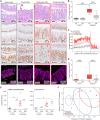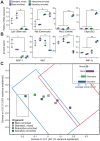The colonic epithelium plays an active role in promoting colitis by shaping the tissue cytokine profile
- PMID: 29596476
- PMCID: PMC5892915
- DOI: 10.1371/journal.pbio.2002417
The colonic epithelium plays an active role in promoting colitis by shaping the tissue cytokine profile
Abstract
Inflammatory bowel disease (IBD) is a chronic condition driven by loss of homeostasis between the mucosal immune system, the commensal gut microbiota, and the intestinal epithelium. Our goal is to understand how these components of the intestinal ecosystem cooperate to control homeostasis. By combining quantitative measures of epithelial hyperplasia and immune infiltration with multivariate analysis of inter- and intracellular signaling, we identified epithelial mammalian target of rapamycin (mTOR) signaling as a potential driver of inflammation in a mouse model of colitis. A kinetic analysis of mTOR inhibition revealed that the pathway regulates epithelial differentiation, which in turn controls the cytokine milieu of the colon. Consistent with our in vivo analysis, we found that cytokine expression of organoids grown ex vivo, in the absence of bacteria and immune cells, was dependent on differentiation state. Our study suggests that proper differentiation of epithelial cells is an important feature of colonic homeostasis because of its effect on the secretion of inflammatory cytokines.
Conflict of interest statement
The authors have declared that no competing interests exist.
Figures







Similar articles
-
A novel mouse model of inflammatory bowel disease links mammalian target of rapamycin-dependent hyperproliferation of colonic epithelium to inflammation-associated tumorigenesis.Am J Pathol. 2010 Feb;176(2):952-67. doi: 10.2353/ajpath.2010.090622. Epub 2009 Dec 30. Am J Pathol. 2010. PMID: 20042677 Free PMC article.
-
Gut Epithelial Vitamin D Receptor Regulates Microbiota-Dependent Mucosal Inflammation by Suppressing Intestinal Epithelial Cell Apoptosis.Endocrinology. 2018 Feb 1;159(2):967-979. doi: 10.1210/en.2017-00748. Endocrinology. 2018. PMID: 29228157 Free PMC article.
-
Chitosan oligosaccharide as potential therapy of inflammatory bowel disease: therapeutic efficacy and possible mechanisms of action.Pharmacol Res. 2012 Jul;66(1):66-79. doi: 10.1016/j.phrs.2012.03.013. Epub 2012 Mar 28. Pharmacol Res. 2012. PMID: 22475725
-
TGF-β in inflammatory bowel disease: a key regulator of immune cells, epithelium, and the intestinal microbiota.J Gastroenterol. 2017 Jul;52(7):777-787. doi: 10.1007/s00535-017-1350-1. Epub 2017 May 22. J Gastroenterol. 2017. PMID: 28534191 Review.
-
Gut microbiota and mTOR signaling: Insight on a new pathophysiological interaction.Microb Pathog. 2018 May;118:98-104. doi: 10.1016/j.micpath.2018.03.021. Epub 2018 Mar 13. Microb Pathog. 2018. PMID: 29548696 Review.
Cited by
-
Ulcerative Colitis-Derived Colonoid Culture: A Multi-Mineral-Approach to Improve Barrier Protein Expression.Front Cell Dev Biol. 2020 Nov 23;8:577221. doi: 10.3389/fcell.2020.577221. eCollection 2020. Front Cell Dev Biol. 2020. PMID: 33330453 Free PMC article.
-
Expression of SARS-CoV-2 Entry Molecules ACE2 and TMPRSS2 in the Gut of Patients With IBD.Inflamm Bowel Dis. 2020 May 12;26(6):797-808. doi: 10.1093/ibd/izaa085. Inflamm Bowel Dis. 2020. PMID: 32333601 Free PMC article.
-
Bridging systems biology and tissue engineering: Unleashing the full potential of complex 3D in vitro tissue models of disease.Biophys Rev (Melville). 2024 Apr 10;5(2):021301. doi: 10.1063/5.0179125. eCollection 2024 Jun. Biophys Rev (Melville). 2024. PMID: 38617201 Free PMC article. Review.
-
Patient-derived organoids for therapy personalization in inflammatory bowel diseases.World J Gastroenterol. 2022 Jun 28;28(24):2636-2653. doi: 10.3748/wjg.v28.i24.2636. World J Gastroenterol. 2022. PMID: 35979165 Free PMC article. Review.
-
Single-cell atlas of the aging mouse colon.iScience. 2022 Apr 4;25(5):104202. doi: 10.1016/j.isci.2022.104202. eCollection 2022 May 20. iScience. 2022. PMID: 35479413 Free PMC article.
References
-
- Mowat C, Cole A, Windsor A, Ahmad T, Arnott I, Driscoll R, et al. Guidelines for the management of inflammatory bowel disease in adults. Gut. 2011;60(5):571–607. doi: 10.1136/gut.2010.224154 . - DOI - PubMed
-
- Jostins L, Ripke S, Weersma RK, Duerr RH, McGovern DP, Hui KY, et al. Host-microbe interactions have shaped the genetic architecture of inflammatory bowel disease. Nature. 2012;491(7422):119–24. doi: 10.1038/nature11582 . - DOI - PMC - PubMed
-
- Khor B, Gardet A, Xavier RJ. Genetics and pathogenesis of inflammatory bowel disease. Nature. 2011;474(7351):307–17. doi: 10.1038/nature10209 . - DOI - PMC - PubMed
-
- Roda G, Sartini A, Zambon E, Calafiore A, Marocchi M, Caponi A, et al. Intestinal epithelial cells in inflammatory bowel diseases. World J Gastroenterol. 2010;16(34):4264–71. doi: 10.3748/wjg.v16.i34.4264 . - DOI - PMC - PubMed
-
- Peterson LW, Artis D. Intestinal epithelial cells: regulators of barrier function and immune homeostasis. Nat Rev Immunol. 2014;14(3):141–53. doi: 10.1038/nri3608 . - DOI - PubMed
Publication types
MeSH terms
Substances
Grants and funding
LinkOut - more resources
Full Text Sources
Other Literature Sources
Molecular Biology Databases
Miscellaneous

